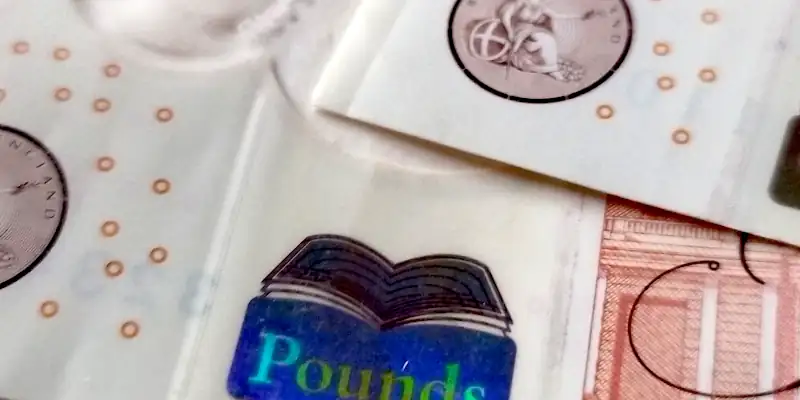The history of banknotes can be traced back to ancient China, where merchants would use paper receipts to represent the value of goods stored in a warehouse. Over time, these paper receipts became a currency and eventually evolved into the banknotes we use today.
As banknotes became more widespread, the need for security measures to prevent counterfeiting also increased. In the early days of banknotes, security features were relatively simple, such as using unique paper or printing notes in specific colours. However, as technology advanced, so did the sophistication of the security measures used in banknotes.
Watermark
One of the most common security measures used in paper banknotes is watermarks. A watermark is an image or pattern incorporated into the banknote paper during the manufacturing process. It can be seen when held up to the light and is difficult to replicate. Watermarks are often used with other security features, such as serial numbers or security threads, to make it even more difficult to counterfeit the banknote.
Security threads
Another commonly used security feature is security threads. A security thread is a thin strip embedded in the banknote paper, and it can be seen when held up to the light and often has text or images that can only be seen under UV light. Security threads can be made of various materials, such as metal or polymer, and can be embedded in different locations on the banknote.
Holograms
Holograms are another security feature commonly used in banknotes. Holograms are images that change colour or shape when viewed from different angles, and they are often used on the plastic windows of banknotes and can be difficult to replicate. Some holograms may contain micro text or other hidden features that can only be seen under magnification.
Intaglio printing
Intaglio printing is another printing technique commonly used in banknotes. Intaglio printing produces raised ink on the banknote’s surface, giving it a unique texture. This technique is difficult to replicate and can also produce fine details, such as portraits or intricate designs.
Microprinting
Microprinting involves printing tiny text or images that are difficult to replicate. They are often used in the background of the banknote and can only be seen under a magnifying glass. Microprinting is also used with other security features, such as watermarks or threads, to make the banknote even more secure.
UV features
UV features are also commonly used in banknotes. UV features are images or text only visible under UV light. They are often used on the front and back of the banknote and can be difficult to replicate. Some UV features may also be combined with other security features, such as watermarks or serial numbers, to increase the overall security of the banknote.
Serial numbers
Serial numbers are used to identify each banknote and help prevent counterfeiting. Each banknote has a unique serial number printed in a specific font or location. These numbers can be checked against a database of valid serial numbers to determine the banknote’s authenticity.
Polymer
Finally, some countries use polymer banknotes made of plastic material, which are more durable and difficult to counterfeit than traditional paper banknotes. Polymer banknotes can also incorporate other security features, such as holograms or UV features, to make them even more secure.
Security measures
Security measures used in banknotes worldwide have come a long way since the early days of paper receipts. Today, banknotes use sophisticated security features, such as watermarks, threads, holograms, intaglio printing, microprinting, UV features, serial numbers, and polymer materials. These security features work together to make banknotes difficult to counterfeit and help maintain the integrity of currency around the world. While these security measures effectively prevent counterfeiting, they must also be continually updated to stay ahead of technological advances used by counterfeiters.
Counterfeit
Counterfeit banknotes can be a significant problem for countries, leading to economic instability and a loss of trust in the currency. To combat this, many countries have established specialized agencies or departments to monitor and prevent counterfeit banknotes from circulating. These agencies often work with law enforcement and financial institutions to identify and investigate counterfeit activity.
Authenticity
In addition to the security measures used in banknotes, many countries also use cash-handling equipment to verify the authenticity of banknotes. Cash handling equipment can detect security features, such as watermarks, security threads, and UV features, to quickly identify counterfeit banknotes. This equipment is often used in banks, retail stores, and other locations where cash is frequently handled.
Technology
The use of technology is also helping to improve the security of banknotes. For example, some countries are exploring blockchain technology to create a digital ledger for every banknote issued. This would make it easier to track the movement of banknotes and quickly identify counterfeit activity.
While the security measures used in banknotes worldwide are effective in preventing counterfeiting, it’s important to note that they are not foolproof. Counterfeiters constantly look for ways to replicate security features or create new counterfeiting methods. Therefore, security measures must continue to evolve to stay ahead of counterfeiters.
Conclusion
Security measures used in banknotes worldwide play a critical role in maintaining the currency’s integrity. From watermarks and security threads to holograms and polymer materials, these features work together to make banknotes difficult to counterfeit. However, security measures must evolve as technology advances to stay ahead of counterfeiters. With continued advancements in technology and collaboration between agencies, countries can work together to maintain the security of banknotes and protect their economies from counterfeit activity.

